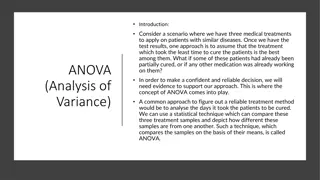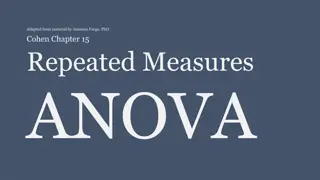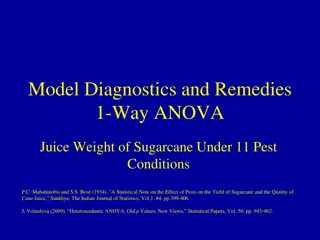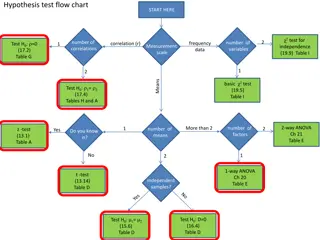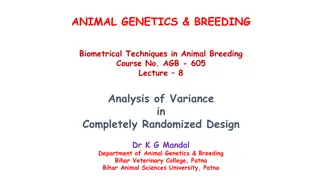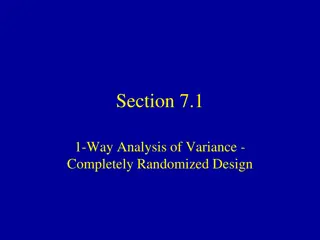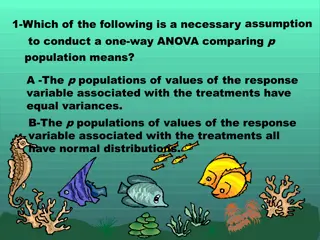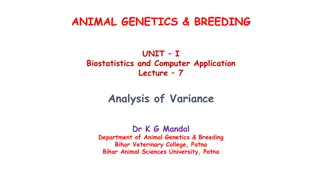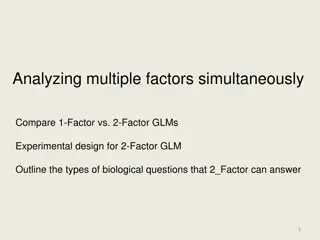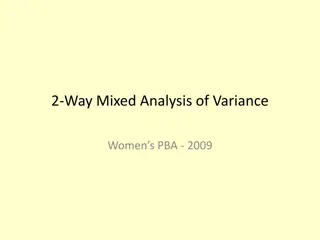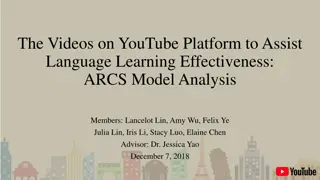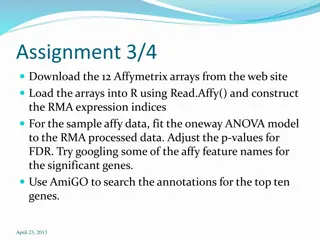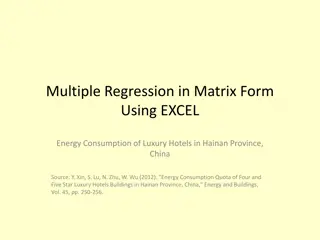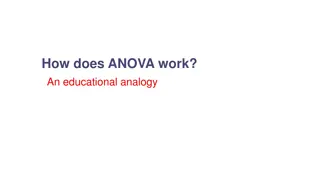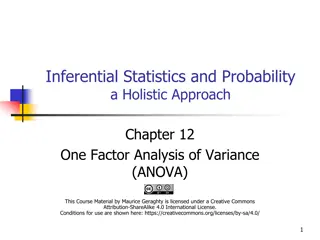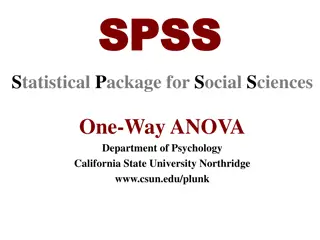Applied Statistics in Psychology: Bridging Theory and Research
This course focuses on teaching applied statistics in psychology, with an emphasis on inferential statistics such as t-tests, ANOVA, correlation, regression, and chi-square. Real-world examples, diversity research, and connections to research methodology are highlighted throughout the course to enha
0 views • 23 slides
ANOVA: Analyzing Variance in Medical Treatments
Explore how ANOVA (Analysis of Variance) can help in comparing multiple medical treatments by analyzing the days taken for patients to be cured. ANOVA checks if means of different groups are significantly different, providing a reliable method to make informed treatment decisions. Learn the basics,
1 views • 10 slides
Repeated Measures ANOVA in Research Studies
Repeated Measures ANOVA is a statistical method used in research to analyze data collected from the same subjects under different conditions or at multiple time points. This method allows for comparing means across various treatments or time intervals within the same group, offering insights into wi
0 views • 52 slides
Statistical Analysis of Sugarcane Juice Weight Under 11 Pest Conditions
This study investigates the impact of various pest conditions on the weight of sugarcane juice through a 1-way ANOVA analysis. Experimental units consisted of grouped canes with different treatments including healthy control and various infestations. The analysis includes model diagnostics, populati
3 views • 18 slides
Analysis of Variance (ANOVA) for Testing Multiple Group Differences
Testing for differences among three or more groups can be effectively done using Analysis of Variance (ANOVA). By focusing on variance between means, ANOVA allows for comparison of multiple groups while avoiding issues of dependence and multiple comparisons. Sir Ronald Fisher's ANOVA method provides
3 views • 28 slides
Design and Analysis of Engineering Experiments in Practice
Explore the fundamentals of engineering experiments, including blocking and confounding systems for two-level factorials. Learn about replicated and unreplicated designs, the importance of blocking in a replicated design, ANOVA for blocked designs, and considerations for confounding in blocks. Dive
1 views • 15 slides
Biometrical Techniques in Animal Breeding: Analysis of Variance in Completely Randomized Design
Biometrical techniques in animal breeding involve the use of analysis of variance (ANOVA) to partition total variance into different components attributable to various factors. In completely randomized designs, experimental units are randomly assigned to treatments, ensuring homogeneity. The total n
1 views • 34 slides
Analysis of Variance in Completely Randomized Design
This content covers the analysis of variance in a completely randomized design, focusing on comparing more than two groups with numeric responses. It explains the statistical methods used to compare groups in controlled experiments and observational studies. The content includes information on 1-way
0 views • 48 slides
Popcorn Production: An In-depth Analysis
Explore the intricacies of popcorn production through detailed data sets, ANOVA tables, types, batch sizes, interaction plots, and Tukey tests. Learn about testing interaction means and delving into new ANOVA tables to uncover insights into popcorn variants. Dive into the world of popcorn research w
1 views • 16 slides
ANOVA in Experimental Design
In this educational content, we delve into the key concepts of ANOVA (Analysis of Variance) in experimental design. Topics covered include the necessary assumptions for conducting one-way ANOVA, the importance of testing factors in two-way ANOVA, various types of sum of squares, comparisons between
3 views • 15 slides
Analysis of Variance (ANOVA) in Animal Genetics & Breeding
ANOVA is a statistical method that partitions the total variance into components attributable to different factors in animal genetics and breeding. This lecture covers the concept of ANOVA, its types, application in Completely Randomized Design, calculations of Sum of Squares, and Mean Squares. It e
0 views • 36 slides
Statistical Analysis Review - An Overview
Explore a diverse range of statistical topics including Chi-Square, Repeated Measures ANOVA, Factorial Design, and Correlation. Learn about scale measurement requirements for Chi-Square, assumptions violation, effect size measures, within-subjects design considerations, and more.
1 views • 51 slides
Analyzing Experimental Design with One-Factor and Two-Factor GLMs
Comparing the experimental designs of one-factor (1-way ANOVA) and two-factor GLMs, this content explores biological questions that can be answered through the analysis of multiple factors simultaneously in experiments. It discusses sample sizes, drug treatments, factor levels, and concentration var
1 views • 13 slides
Analysis of Variance in Women's Professional Bowling Association - 2009
This study conducted a 2-Way Mixed Analysis of Variance on the Women's Professional Bowling Association qualifying rounds in 2009 at Alan Park, Michigan. The analysis focused on factors including oil pattern variations and different bowlers, each rolling sets of games on different patterns to measur
1 views • 16 slides
Enhancing Language Learning Effectiveness Through YouTube Videos: ARCS Model Analysis
This project explores utilizing YouTube videos to enhance language learning effectiveness using the ARCS motivation model. The study focuses on improving student motivation, attention, and achievement in English language courses through innovative teaching methods and technology integration. The res
2 views • 19 slides
Analysis of Affymetrix Arrays Using RMA and ANOVA Model
Downloaded Affymetrix arrays were loaded into R using ReadAffy(), followed by fitting the oneway ANOVA model to the RMA processed data and adjusting p-values for false discovery rate. Significant genes were identified and their annotations searched using AmiGO.
0 views • 11 slides
Two-Way ANOVA Analysis of Sleep Deprivation and Stimulant Effects on Driving Performance
This study presents a two-way ANOVA analysis involving sleep deprivation conditions and stimulant effects on driving performance in a simulated truck driving task. The research explores the impact of different sleep deprivation scenarios and stimulant types on individuals' scores in a video game tha
0 views • 10 slides
Multiple Regression Analysis of Energy Consumption in Luxury Hotels - Hainan Province, China
Conducting a multiple regression analysis on the energy consumption of luxury hotels in Hainan Province, China using matrix form in Excel. The dataset includes 19 luxury hotels with the dependent variable being energy consumption (1M kWh) and predictors such as area, age, and effective number of gue
0 views • 13 slides
ANOVA Through an Educational Analogy
Imagine students as data points and deciding whether to employ a tutor as introducing a new variable in ANOVA analysis. Just like managing student-teacher ratios, ANOVA involves analyzing data points and deciding if adding a variable is worth the cost based on how much it contributes to the analysis
0 views • 9 slides
Basics of Hypothesis Testing in Gene Expression Profiling
The lecture covers the essential aspects of hypothesis testing in gene expression profiling, emphasizing experimental design, confounding factors, normalization of samples, linear modeling, gene-level contrasts, t-tests, ANOVA, and significance assessment techniques. Practical insights are shared on
0 views • 9 slides
Importance of Statistical Design and Analysis in Biofilm Research
The importance of statistical thinking in biofilm research is highlighted through standardized methods, statistical tool applications like ANOVA, and attributes of a standard method such as Relevance, Reasonableness, and Reproducibility. Statistical design aids in generating convincing results, anti
0 views • 33 slides
One Factor Analysis of Variance (ANOVA)
One Factor Analysis of Variance (ANOVA) is a statistical method used to compare means of three or more groups. This method involves defining factors, measuring responses, examining assumptions, utilizing the F-distribution, and formulating hypothesis tests. ANOVA requires that populations are normal
0 views • 23 slides
Two-Way ANOVA Analysis of Complex Motor Tasks in a Sleep Deprivation Study
The study investigates the impact of sleep deprivation and stimulant types on motor task performance in a driving simulation game. Factors such as sleep deprivation methods (control, jet lag, interrupted, total deprivation) and stimulant types (placebo, caffeine, reward) are analyzed through a two-w
1 views • 10 slides
Analgesic Study with Three Treatments Crossed with Gender
This study explores the effects of analgesic treatments crossed with gender on pain levels. The data analysis includes factors such as gender and drug type, and the statistical model examines pain index as a linear function of factor levels. The ANOVA results indicate significant effects of gender,
0 views • 17 slides
Fixed effects analysis in a Two – way ANOVA
Two-way ANOVA analysis focusing on fixed effects with crossed main effects and nested experimental units. Understand the parameters, hypotheses, expected mean squares, and ANOVA effect tests to evaluate Phosphor Type, Glass Type, and their interaction. Perform interaction plots and examine main effe
1 views • 25 slides
Comprehensive Guide to ANOVA and Results Analysis
A detailed breakdown of ANOVA results and analysis including within-group, between-group, main effects, and interaction effects. Discover in-depth explanations and visual representations to aid your understanding of statistical analysis.
0 views • 9 slides
Design of Mixed ANOVA in Research
Using a Mixed ANOVA design in research involves factors like repeated measures, between-subjects variables, and understanding how to analyze within-subjects variability. The design allows for comparing different treatments at various time points and exploring the impact of independent variables on t
0 views • 10 slides
SPSS One-Way ANOVA at California State University Northridge
The SPSS statistical package is used for conducting One-Way ANOVA to analyze differences between groups on a dependent variable. This guide covers how to run One-Way ANOVA in SPSS at the Department of Psychology, California State University Northridge. It includes step-by-step instructions with visu
0 views • 17 slides
Three-Way Mixed ANOVA in Research
Conducting a Three-Way Mixed ANOVA in research involves analyzing the main effects and interactions of multiple independent variables using data in long format. This method allows researchers to determine the significance of various factors on the dependent variable. Learn how to interpret the resul
0 views • 26 slides
Designing Experiments
The assumptions of ANOVA and 1-factor GLM, focusing on random sampling and independence. Learn about assigning samples to treatments through random and grouped approaches, and the importance of randomness in experimental design. Discover how to spot pseudo-replication in ANOVA and the significance o
0 views • 19 slides
FACTORIAL ANOVA
Dr. Petrov plans an experiment to study the impact of teaching methods and sex differences on learning outcomes using factorial ANOVA. The design includes row and column factors, with different levels for each, to analyze the data effectively. The means tables provide a summary of the experiment's d
0 views • 58 slides
Factorial ANOVA Experiment Analysis
Dr. Petrov is exploring the impact of teaching methods and sex differences on learning outcomes through a factorial ANOVA experiment. The study involves different factors such as teaching method, sex, and student participation, aiming to assess how these variables interact and influence the results.
0 views • 36 slides
Factorial ANOVA: Understanding Experimental Design
Factorial ANOVA, Experimental Design, Analysis of Variance, Learning Outcomes, Research
0 views • 51 slides
Understanding Analysis of Variance (ANOVA) for Comparing Multiple Means
This presentation covers the concept of Analysis of Variance (ANOVA) for comparing multiple means, particularly focusing on Chapter 27 topics such as F-test, conditions for ANOVA, F distributions, and degrees of freedom. An example comparing several means of tropical flowers is provided to illustrat
0 views • 22 slides
Understanding Repeated Measures Designs in ANOVA
This presentation delves into the benefits, challenges, and solutions related to repeated measures designs in Analysis of Variance (ANOVA). Key topics include the rationale for using repeated measures, advantages such as increased sensitivity and reduced variance, and common statistical problems lik
0 views • 44 slides
Understanding ANOVA for Reliable Statistical Analysis
Explore the concept of ANOVA (Analysis of Variance) as a statistical technique used to compare means of different groups, investigate factors influencing dependent variables, and make informed decisions based on reliable data analysis.
0 views • 10 slides
Factors Affecting Variance in ANOVA Models
Explore the concepts of random and mixed effects ANOVA models, focusing on 1-way random effects model and statistical parameters of interest. Understand how the analysis of variance is conducted to test equality among parameters such as MSE and MSTR. Dive into the realm of testing procedures in ANOV
1 views • 17 slides
Understanding ANOVA for Statistical Analysis
ANOVA (Analysis of Variance) is a powerful statistical method introduced by R.A. Fisher in 1920. It allows for comparison of means and is widely used in social sciences to test hypotheses about differences between multiple means. ANOVA helps avoid the increased risk of Type I errors associated with
1 views • 14 slides
Understanding Analysis of Variance (ANOVA) for Statistical Analysis
Explore the fundamentals of Analysis of Variance (ANOVA), a statistical technique used to analyze variability in data and infer inequality among population means. Learn about the differences between ANOVA and t-tests, the basic ANOVA situation, hypotheses, and assumptions required. Gain insights int
0 views • 28 slides
Understanding Repeated Measures ANOVA in Research
Explore the concept of Repeated Measures ANOVA along with examples, design types, and its advantages in research. Learn about factors, outcome variables, and comparisons with Independent Groups ANOVA for a comprehensive understanding of statistical analysis in experiments.
0 views • 52 slides

